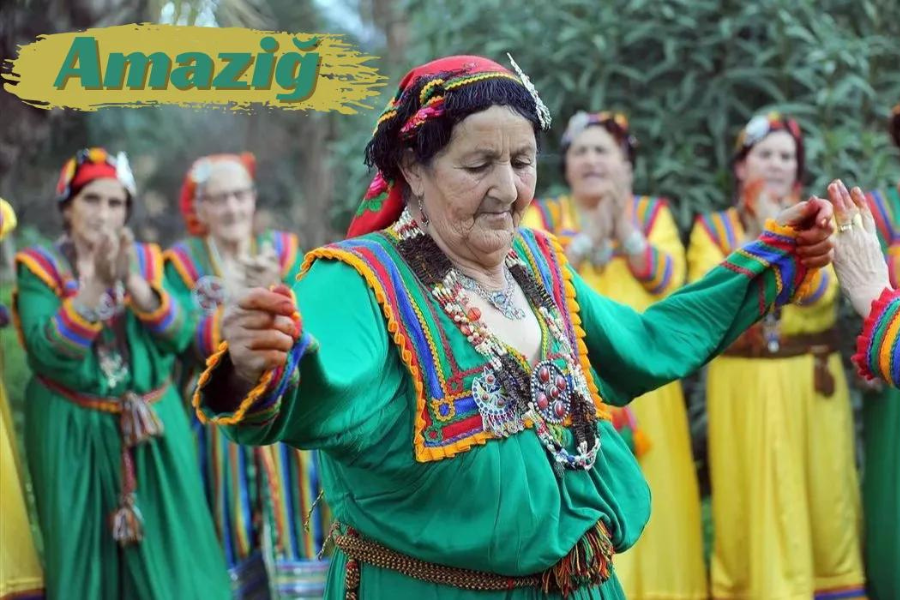Amaziğ Legacy: Unveiling the Timeless Traditions of North Africa’s Indigenous People
Introduction to the Amaziğ Culture
North Africa is a place that is known for rich history and different societies, however one of its most lively strings frequently slips by everyone’s notice: the Amaziğ public. These native occupants have woven their remarkable character into the texture of the district with their beautiful customs, spellbinding stories, and well established convictions. The Amaziğ culture, otherwise called Berber culture, holds a gold mine of intelligence that reflects flexibility and association with nature. As we investigate this captivating world, get ready to be propelled by stories from old times to advanced battles for social conservation. Go along with us on an enlightening excursion through the core of North Africa’s Amaziğ legacy!
The Set of experiences and Starting points of the Amaziğ Public
The Amaziğ public, frequently known as Berbers, have occupied North Africa for millennia. Their starting points follow back to antiquated times, with proof proposing they were among the district’s earliest occupants.
Semantic investigations uncover that the Amazigh dialects have a place with a part of the Afro-Asiatic language family. This rich semantic legacy mirrors their significant association with the land and its set of experiences.
All through hundreds of years, these versatile networks adjusted to different impacts from attacking domains and adjoining societies while keeping up with their novel personality. From Romans to Middle Easterners, each experience formed their traditions and lifestyle.
Regardless of outer tensions, the Amaziğ culture has flourished in cruel desert scenes and uneven areas. Today, they keep on praising their customs through workmanship, music, and oral narrating — a demonstration of their getting through inheritance inside North Africa’s different embroidery.
Social Practices and Convictions of the Amaziğ
The Amaziğ culture is wealthy in lively customs and well established convictions that mirror their association with the land and local area. Music assumes a focal part, with cadenced songs going with festivities, ceremonies, and narrating. Instruments like the guembri and bendir carry life to get-togethers.
Their craft prospers through complicated woodwork, stoneware, and vivid materials enhanced with images addressing security and ripeness. Each piece recounts to a story saturated with history.
Otherworldliness is woven into day to day existence. The Amaziğ public frequently practice animism, accepting that spirits occupy normal components like waterways or mountains. This respect for nature cultivates a manageable way of life.
Family ties are fundamental inside their cultural construction. Elderly folks hold shrewdness went down through ages, directing more youthful individuals in custom while imparting upsides of regard and solidarity. These social practices make a getting through feeling of personality among the Amaziġ nation today.
The Impact of Amaziğ Culture on North Africa
The Amaziğ culture has significantly molded the personality of North Africa. From engineering to language, their impact is woven into the texture of day to day existence.
Berber dialects, including Tamazight and Tarifit, improve the etymological variety in nations like Morocco and Algeria. These dialects convey antiquated stories and customs that have endure hundreds of years.
Culinary practices are one more sign of Amaziğ legacy. Tagines, couscous dishes, and home grown teas mirror a rich gastronomic practice went down through ages.
Imaginativeness flourishes inside amaziɣ networks as well. Beautiful materials and many-sided earthenware feature extraordinary craftsmanship that resounds with both nearby inhabitants and guests the same.
Celebrations celebrating harvests or verifiable occasions unite networks, protecting common bonds. Music likewise assumes a critical part; customary rhythms reverberation through festivals and narrating get-togethers across the district.
Such social components keep on rousing contemporary craftsmen while supporting connections to genealogical roots in present day culture.
Current Difficulties and Safeguarding Endeavors
The Amaziğ public face various difficulties today. Urbanization and globalization undermine their customary lifestyle. As urban communities extend, numerous youngsters relocate to look for gainful employment, leaving country regions defenseless.
Social disintegration is a squeezing concern. The rich dialects, expressions, and customs of the Amaziğ are in danger of disappearing. Endeavors to rejuvenate these practices have picked up speed lately.
Grassroots associations assume a fundamental part in conservation. They advance language schooling and social studios across North Africa. Celebrations observing Amaziğ legacy unite networks, encouraging pride among the more youthful age.
Coordinated effort with states is pivotal for feasible advancement drives that regard native privileges. Ecotourism likewise offers new roads for financial development while safeguarding regular scenes important to theAmaziğ culture.
Connecting with global accomplices can enhance these endeavors further, guaranteeing that this energetic culture keeps on flourishing in the midst of present day pressures.
Must-visit Objections for Drenching in Amaziğ Culture
To really encounter the wealth of Amaziğ culture, certain objections stick out. One should visit the captivating town of Imlil in Morocco’s High Chart book Mountains. Settled among stunning pinnacles, it’s a door to customary Amazigh life.
The dynamic city of Marrakech is another fundamental stop. The clamoring souks and verifiable locales offer looks into Amaziğ creativity and craftsmanship. Make certain to investigate the neighborhood markets for carefully assembled carpets and earthenware made by talented craftsmans.
Head further south to Essaouira, where seaside excellence meets rich legacy. This UNESCO World Legacy site grandstands dazzling engineering impacted by Amazigh plan.
Adventure into Tunisia’s Matmata locale. Here lies an unprecedented shut-in local area that reflects old customs still alive today. Every objective recounts this versatile culture ready to be found.
Conclusion: Appreciating and Regarding Native Societies
The Amaziğ culture is a lively embroidery woven from hundreds of years of history, custom, and flexibility. As we dig further into their reality, obviously the extravagance of this native culture merits our consideration and regard. The qualities implanted in Amaziğ customs offer experiences into economical living and local area union.
Understanding the difficulties looked by the Amaziğs public today features the significance of protection endeavors. These drives are pivotal for keeping up with social way of life as well as for cultivating appreciation among different networks around the world.
Investigating objections attached to Amaziğ legacy permits us to draw in with their traditions firsthand. It opens ways to significant cooperations that can connect holes between societies.
Perceiving and esteeming native societies like that of the Amaziğ enhances our worldwide account. Every special story adds profundity to humankind’s aggregate insight, helping all of us to remember the excellence tracked down in variety and shared accounts. Embracing these rich practices empowers common regard and grasping in an undeniably interconnected world.
FAQs
1. What is Amaziğ culture?
Amaziğ culture, also known as Berber culture, refers to the traditions, customs, and way of life of the Amaziğ people who have lived in North Africa for thousands of years. It encompasses their language, art, music, spiritual beliefs, and social practices.
2. Where are the Amaziğ people located?
The Amaziğ people are indigenous to North Africa, with significant populations in Morocco, Algeria, Tunisia, and parts of Libya and Mali. They inhabit diverse environments including the Atlas Mountains, coastal areas, and desert regions.
3. What are some key aspects of Amaziğ social practices?
Amaziğ social practices include a rich tradition of music and dance, intricate craftsmanship in woodwork and pottery, and a deep connection to nature through animistic beliefs. Family and community ties are central, with elders playing a vital role in preserving traditions and guiding younger generations.
4. How has Amaziğ culture influenced North African society?
Amaziğ culture has greatly influenced North African society through its contributions to language, cuisine, art, and festivals. Amaziğ languages like Tamazight and Tarifit are spoken in various regions, and traditional dishes such as tagines and couscous are integral to North African cuisine.
5. What are the current challenges faced by the Amaziğ people?
The Amaziğ people face challenges such as urbanization, globalization, and the risk of cultural erosion. Many young Amaziğ migrate to cities for economic opportunities, leading to a decline in traditional practices and languages.
6. What efforts are being made to preserve Amaziğ culture?
Preservation efforts include grassroots initiatives promoting language education, cultural festivals, and workshops. Collaboration with governments and organizations, along with the promotion of ecotourism, also supports the preservation and celebration of Amaziğ heritage.
7. What are some must-visit places to experience Amaziğ culture?
To experience Amaziğ culture, visit Imlil in Morocco’s High Atlas Mountains, Marrakech for its vibrant markets and craftsmanship, Essaouira for its architectural heritage, and Tunisia’s Matmata for its traditional troglodyte dwellings.
8. How does Amaziğ spirituality manifest in daily life?
Amaziğ spirituality often involves animism, with a belief that spirits inhabit natural elements such as rivers, mountains, and trees. This respect for nature is reflected in their sustainable practices and cultural rituals.
9. What role does music play in Amaziğ culture?
Music is a vital part of Amaziğ culture, used in celebrations, ceremonies, and storytelling. Traditional instruments like the guembri and bendir are central to their musical heritage, providing rhythms and melodies that enhance social gatherings.
10. How can individuals support and engage with Amaziğ culture?
Individuals can support Amaziğ culture by learning about their traditions, visiting cultural sites, participating in festivals, and supporting organizations dedicated to cultural preservation. Respecting and promoting the Amaziğ language and heritage in various platforms also helps in sustaining their legacy.
Stay up-to-date with the latest celebrity news and gossip at SyncTimes.co.uk.






